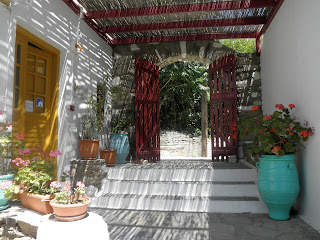 The entryway to Hotel Aegean Village. My new home for four weeks.
The entryway to Hotel Aegean Village. My new home for four weeks. This is a typical street in Paros. The streets are gorgeous. The stones on the sidewalk are lined in whitewash to catch the moon light and reflect it at night.
This is a typical street in Paros. The streets are gorgeous. The stones on the sidewalk are lined in whitewash to catch the moon light and reflect it at night.Arriving in Paroikia, Paros, I was greeted unexpectedly by a crowd of hotel owners flailing to catch me as a customer. I kept walking by them looking for Susan Sutton, my professor. After meeting at the windmill, she led us to Hotel Aegean Village, where I am staying for the next four weeks. The island is quite a throwback from living in the big city. Athens was dirty, marked with grafitti and full of stray dogs, cats and people. There was water dripping from the upper balconies and puddles on the street. You couldn't make it half a day without having to wash your feet.
Paros seems more like fantasy than reality. Quaint streets of white washed buildings, none over 3 stories as mandated by law, are highlighted with blue shutters and doors. Occassionally, you’ll see red and once even a hot pink door. The streets are all made of stonework, which is traced in whitewash to catch the moonlight at night. The Hotel Aegean also is accented with grapes over the terrace, as well as olive trees and other fruits. The apartment is much smaller than the one in Athens, but the courtyard and the building itself is charming. It is also nicer to be closer to my classmates. A good number of them are also in the Hotel Aegean Village. After a brief orientation, we were treated to a feast.
Just when I think that I have had the best meal of my life, I am yet again surprised. One gift on being on an island is the seafood. An advocate of sea food by early exposure to sea food on the east coast, I am always eager to have good sea food. Living in the Midwest now makes this a rariety. The dinner started with tsatziki and bread followed with Greek salad. Then they brought out their house salad. It was topped with gold fish just like at mother bear’s! It also had a sweet vinagrette that tasted like a mix of raspberry and vinagrette. We were then treated to these tomato puffs, meatballs and French fries. It just kept coming with a dish of sautéed mushrooms, that were perfectly flavored and covered in butter. Then eggplant dish was brought out after being marinaded in a sweet balsamic. For the sea food component, we had a type of fish salad, which was cooked and served with a mustard sauce on the side. Also, we had deep fried calamari, which was perfectly complemented by the tsatziki dip. It was a dining experience of a lifetime. Eating all these gourmet food, overlooking the Aegean sea. Although, it is not the Greek way to have sweets after dinner, we were served honey puffs, dripping with honey and cinammon. Despite this smorgasboard which most likely is gaining on my waistline, it is said that the Mediterranean diet is one of the healthiest in the world. This could be attributed to the use of olive oil, a monosaturated fat.
This first dinner won me over on day 1 that life on the island was going to be good. Later that night, Rachel, Amanda and I went out on the by the shore. The waves were hitting the rocks harder at night and the moon shone over the waters. We shared a pineapple drink. We enjoyed our tropical drinks seaside in the company of a Los Angeles fellow, a guy from Finland and a Paros native. The Paros native who sported eccentric red and green hair was an interesting character.
In our first class we learned some statistics that put Greece in perspective. I included the following from our lecture if you are interested: Greece is 1 ½ times the size of Indiana. It has 10 million residents, of which 1/3 resides in Athens. There are 13,000 residents in Paros year round. Greece is in the South East corner of Europe on the Balkan penisula. Paros is one of the Cycladic Islands of Greece. Cycladic is a reference to the circular formation. This island has the charm of the old world. Cars are not allowed in the “old part” of the town and are relatively scarce overall. Susan also lectured on the natural setting of Greece and three components of the climate: sun, mountains and the sea. In the Mediterranean climate, there are cool, rainy waters and hot, dry summers. The average summer temperature is 80s and winter is 40s. The terrain has 80% mountains. The coastline is 9,000 miles and 2,000 islands of which 170 are inhabited daily.


No comments:
Post a Comment